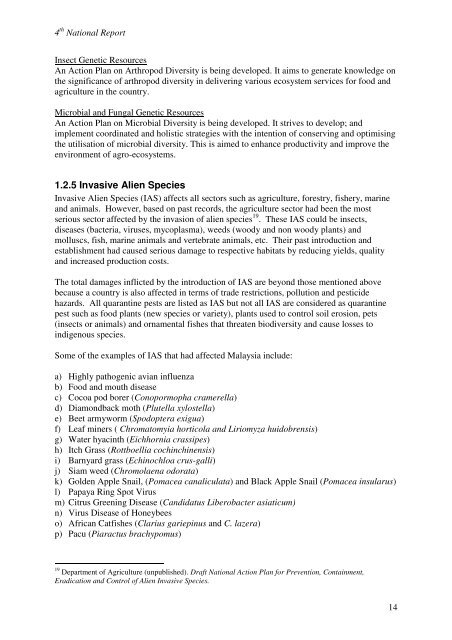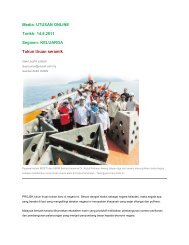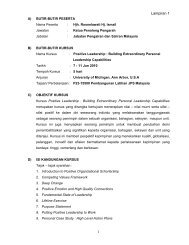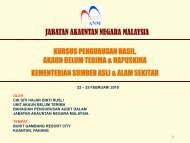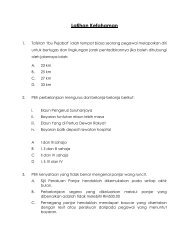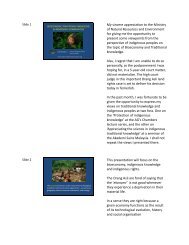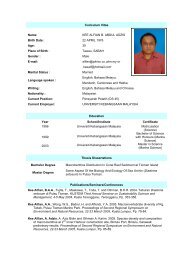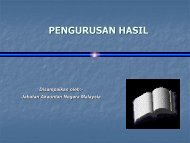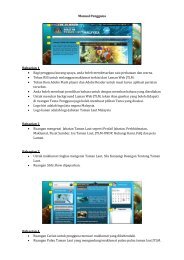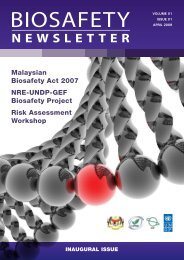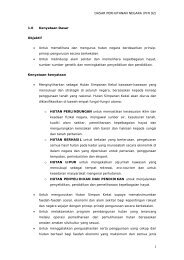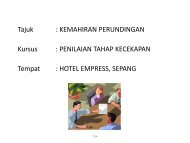4th National Report to CBD - NRE
4th National Report to CBD - NRE
4th National Report to CBD - NRE
Create successful ePaper yourself
Turn your PDF publications into a flip-book with our unique Google optimized e-Paper software.
4 th <strong>National</strong> <strong>Report</strong><br />
Insect Genetic Resources<br />
An Action Plan on Arthropod Diversity is being developed. It aims <strong>to</strong> generate knowledge on<br />
the significance of arthropod diversity in delivering various ecosystem services for food and<br />
agriculture in the country.<br />
Microbial and Fungal Genetic Resources<br />
An Action Plan on Microbial Diversity is being developed. It strives <strong>to</strong> develop; and<br />
implement coordinated and holistic strategies with the intention of conserving and optimising<br />
the utilisation of microbial diversity. This is aimed <strong>to</strong> enhance productivity and improve the<br />
environment of agro-ecosystems.<br />
1.2.5 Invasive Alien Species<br />
Invasive Alien Species (IAS) affects all sec<strong>to</strong>rs such as agriculture, forestry, fishery, marine<br />
and animals. However, based on past records, the agriculture sec<strong>to</strong>r had been the most<br />
serious sec<strong>to</strong>r affected by the invasion of alien species 19 . These IAS could be insects,<br />
diseases (bacteria, viruses, mycoplasma), weeds (woody and non woody plants) and<br />
molluscs, fish, marine animals and vertebrate animals, etc. Their past introduction and<br />
establishment had caused serious damage <strong>to</strong> respective habitats by reducing yields, quality<br />
and increased production costs.<br />
The <strong>to</strong>tal damages inflicted by the introduction of IAS are beyond those mentioned above<br />
because a country is also affected in terms of trade restrictions, pollution and pesticide<br />
hazards. All quarantine pests are listed as IAS but not all IAS are considered as quarantine<br />
pest such as food plants (new species or variety), plants used <strong>to</strong> control soil erosion, pets<br />
(insects or animals) and ornamental fishes that threaten biodiversity and cause losses <strong>to</strong><br />
indigenous species.<br />
Some of the examples of IAS that had affected Malaysia include:<br />
a) Highly pathogenic avian influenza<br />
b) Food and mouth disease<br />
c) Cocoa pod borer (Conopormopha cramerella)<br />
d) Diamondback moth (Plutella xylostella)<br />
e) Beet armyworm (Spodoptera exigua)<br />
f) Leaf miners ( Chroma<strong>to</strong>myia horticola and Liriomyza huidobrensis)<br />
g) Water hyacinth (Eichhornia crassipes)<br />
h) Itch Grass (Rottboellia cochinchinensis)<br />
i) Barnyard grass (Echinochloa crus-galli)<br />
j) Siam weed (Chromolaena odorata)<br />
k) Golden Apple Snail, (Pomacea canaliculata) and Black Apple Snail (Pomacea insularus)<br />
l) Papaya Ring Spot Virus<br />
m) Citrus Greening Disease (Candidatus Liberobacter asiaticum)<br />
n) Virus Disease of Honeybees<br />
o) African Catfishes (Clarius gariepinus and C. lazera)<br />
p) Pacu (Piaractus brachypomus)<br />
19 Department of Agriculture (unpublished). Draft <strong>National</strong> Action Plan for Prevention, Containment,<br />
Eradication and Control of Alien Invasive Species.<br />
14


